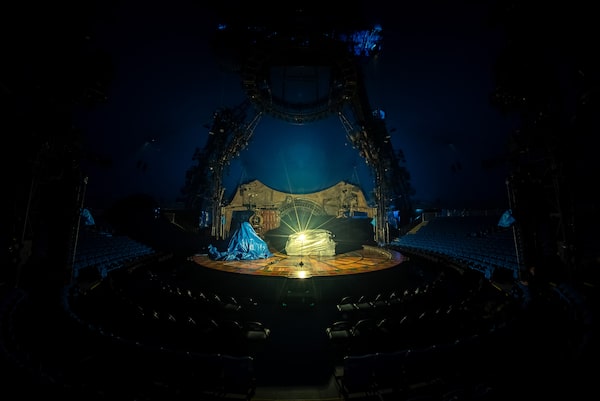
In the theatre, it’s traditional to leave a “ghost light” burning after everyone’s left. That’s what happened at Flemington Racecourse in Melbourne. It stayed lit for more than a yearScott Barton, Kurios - Cabinet of Curiosities/Cirque du Soleil
On a sunny afternoon in March 2020, a small crowd shuffled into Cirque du Soleil’s sprawling tent-shaped theatre at the Disney Springs resort in Orlando for a mini-preview of its new show, Drawn to Life. Once inside, everyone’s sense of perspective was immediately put to the test. A towering lamp loomed over the stage, its bulb the size of a baby elephant. Twenty-foot-tall pencils stood in a jar near an old-timey pencil sharpener that would take a team of six to operate. Dozens of bedsheet-size sketchpad pages hung overhead. This was what it must be like to be shrunk down to size and perched on an animator’s table. The effect was Lilliputian. Or, since this was a Cirque-Disney co-production, Jiminy Cricketian.
Drawn to Life tells the story of Julie, a young girl whose animator father has died (in keeping with Disney’s tradition of doing away with parents). When she discovers some of his unfinished animations, she sets out to complete them. The audience that day was made up of reporters, theme-park-industry watchers and Disney employees, and as they took their seats—strangers sitting elbow to elbow, their faces just inches apart—a team of acrobats dressed to look like pencil sketches performed in tandem with animated drawings projected behind them. Then a muscular aerialist twirled a giant pencil dangling from a rope like he was drawing onto a sketchpad on the stage. When an old wooden desk sprang to life and galloped away, delight at the spectacle was apparent on the onlookers’ unmasked faces.
No one there knew it yet, but this was Cirque’s last gasp in the Before Times. In less than two weeks, panicked governments would close borders, people around the world would start to don masks, and the global economy would be put into a coma to fight the spreading virus. By the day of the show’s preview, the mysterious virus had already begun to leave its mark on the company. The city of Wuhan, where the disease originated, sits 800 kilometres west of Hangzhou, home to Cirque’s first permanent show in China, which launched in the summer of 2019. Authorities had ordered live performances in the country shut down, while Cirque’s touring shows in Hong Kong and Italy had also been put on hold.
Even without everything that was about to happen, this was already a critical moment for the company. The jewel of Quebec Inc. had only just announced it was pulling the plug on R.U.N., its newest big-budget resident show in the crucial Las Vegas market, after just five months of dismal reviews. (“An ugly, inconsistent, poorly planned and sloppily executed mess that lies there like a dead body in a ditch,” scathed one critic.) It wasn’t the first Cirque show to get panned and end its run early, but R.U.N. was its most high-profile failure to date and the shortest lifespan of any outing in its history.
For Cirque, then, Drawn to Life was a timely opportunity to reassert its bona fides as a dynamic creative force. It’s a hugely ambitious production, the result of more than two years of collaboration with Disney’s animation team and its Imagineering R&D division, which saw Cirque gain access to the studio’s archive of pencil sketches. It features seven sprawling tracks that loop backstage carrying 250-foot-long drawings that crisscross each other to create a parallax effect—an ode to the seven-layer multiplane camera system Disney perfected to make animated scenery in movies like Snow White and Bambi more realistic. No wonder CEO and 20-year Cirque veteran Daniel Lamarre was so eager to talk up the company’s long game when he stepped on stage, onto a literal blank canvas on the floor. “We are preparing an amazing show that I hope will stay here forever,” he beamed.
Later, after the acrobats and anthropomorphic furniture had wandered into the wings, Lamarre joined me in the front row, where he reflected on everything Cirque was up against. Yes, R.U.N. was a costly flop, he admitted. The financial hit to Cirque was around $20 million and even more to its partner, MGM Resorts International. And yes, the virus was deeply worrying. A crisis unit had been formed just the day before at Cirque’s Montreal headquarters to monitor the risks to its employees and operations.

CEO Daniel Lamarre, in his signature tinted glasses, poses at Cirque’s HQ in February 2020 with moulded heads—one for each performer—that ensure their costumes fit preciselyBenoît Paillé/The Globe and Mail
Yet, Lamarre remained true to his reputation for unshakable optimism, a quality he attributed to having “a very selective memory” that stops him from dwelling on those instances when Cirque’s big creative bets don’t pay off. This moment in the company’s nearly 40-year history is no different, he insisted. “As a robust entertainment organization, we mitigate our risk with a portfolio that is broad enough that if you have bad luck or a bad situation somewhere, you can absorb that without getting the company into trouble,” he said, wearing his trademark tinted glasses. “Look, this is not good, obviously. But it’s not the end of the world.”
Within days, however, Cirque’s world would completely collapse.
Over the past year, Cirque du Soleil granted Report on Business magazine access to its top leaders as they fought to keep the company alive. Along with interviews with Cirque’s former owners, performers, lawyers, past executives and others, they provide a front-row seat to not only the crushing decision to cancel the company’s shows worldwide and lay off 95% of its staff, including acrobats, clowns, musicians and other creative types, but also the complex logistical scramble to unwind Cirque’s vast international operations.
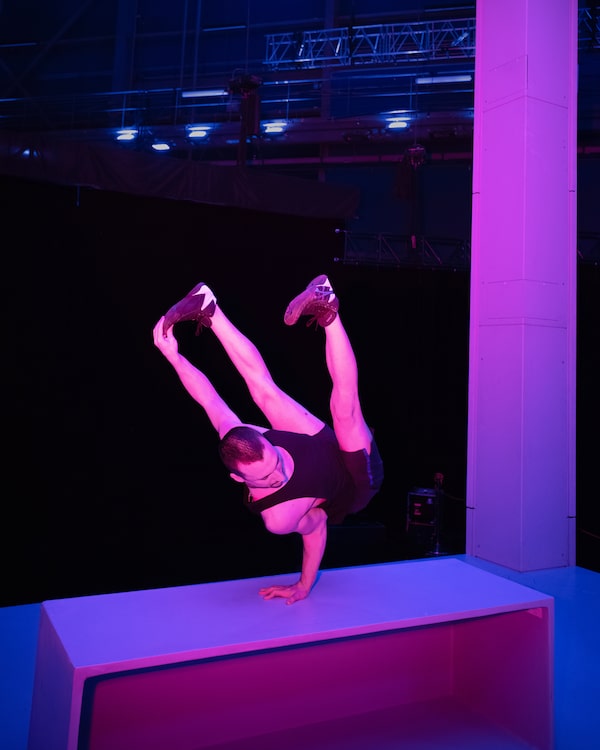
Acrobat practicing during the press conference at Cirque du Soleil's Montreal HQ, Feb 2020Benoît Paillé/The Globe and Mail
And they reveal the financial contortions Cirque had to perform to survive. It’s a company with no real assets beyond its brand and its expertise at creating live extravaganzas. But carrying a staggering amount of debt, Cirque was arguably more exposed to a once-in-a-century pandemic than any other major company in the world. The crisis triggered a desperate scramble for emergency financing that saw Cirque plunged into one of the most complex bankruptcy filings in Canadian corporate history. And it set off a high-stakes, hard-knuckled battle between the powerful private equity firms that controlled the company and its creditors—a clash that ultimately left Cirque in the hands of Toronto-based Catalyst Capital, whose business model includes targeting and seizing control of distressed assets.
Now, with the pandemic’s end in sight, Cirque is opening the door on its plan to revive itself and bring back at least some of its performers, beginning with two of its oldest and most popular shows in Las Vegas this summer. The challenges will be many—from the unpredictability of COVID-19 variants and lingering border restrictions to more fundamental questions about how Cirque will repair its famously close-knit workplace culture and preserve the risk-taking ethos on which it was built.
What Cirque is attempting is the corporate equivalent of the seemingly impossible acrobatics its performers are known for—only it’s doing so after suffering a near-fatal injury. Vast fortunes, personal reputations and the livelihoods of thousands of former employees, not to mention Quebec provincial pride, now ride on Cirque sticking the landing.
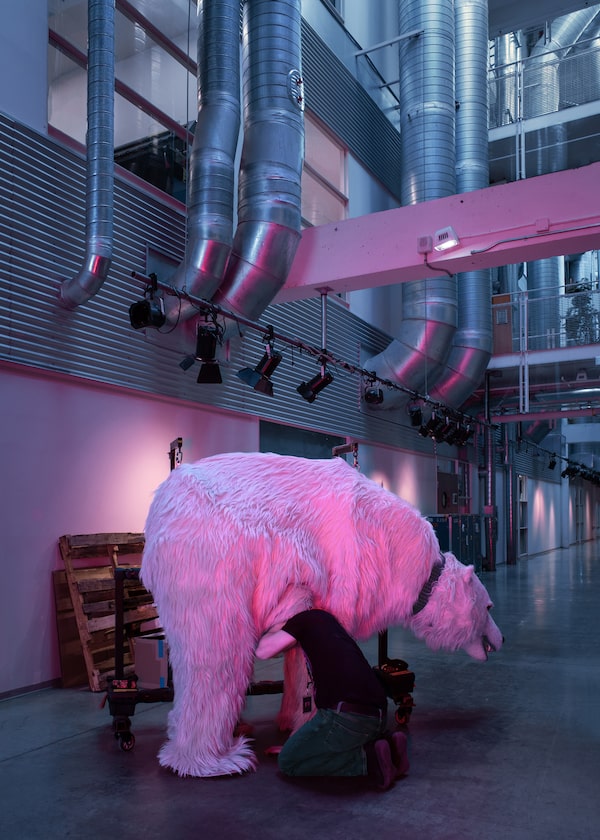
At Cirque’s Montreal HQ in February 2020, an employee tries to fix a fan inside an animatronic polar bearBenoît Paillé/The Globe and Mail
To understand Cirque’s terrible, horrible, no good, very bad year, it helps to know where the company stood going into the crisis and the circumstances that made it so vulnerable when the pandemic hit.
In mid-February 2020, around the time the World Health Organization assigned COVID-19 its official name, but before Quebec had confirmed a single case, Cirque’s headquarters buzzed with activity. Located in the Montreal borough of Saint-Michel, on the site of a former limestone quarry that later served as the province’s largest landfill, the steel and glass structure could be home to just about any multinational corporation, save for the gigantic bronze sculpture of an old leather clown shoe near the entrance. Inside, it’s the kind of place where turning a corner puts you face to face with a life-size animatronic polar bear. Young men and women in fantastical costumes dart in and out of doorways, and a multistorey atrium overflows with employees watching Cirque’s resident clown, Madame Zazou, dressed in a bright red wig and a gown of red and gold felt, lead a raucous lunchtime quiz show. (Guy Laliberté, Cirque’s founder, hired her years ago when he worried the place was becoming too corporate, and Madame Zazou is known for regularly crashing high-level executive meetings to poke fun at Lamarre.)
I’d travelled there from Toronto as part of a story on the business of creativity. Cirque was seemingly the perfect case study. Over 36 years, it had become one of Canada’s most successful exports by turning decades of North American circus tradition on its head, replacing the elephants, lions and clown cars with a fusion of daredevil acrobatics, opera, dance and whimsy. It achieved pop culture status along the way—in Madagascar 3, Alex the Lion riffs on how French Canadians, “drunk off their maple syrup and cheap pharmaceuticals,” completely flipped the paradigm of traditional circuses. It has also spawned a cottage industry of business consultants who teach other companies how to replicate Cirque’s innovation magic.
At full strength—as it was not long before the pandemic struck—the company would put on daily performances of its 13 big-top and arena touring shows in places ranging from Miami, Punta Cana and Seville to London, Brisbane and Paris. It also hosted 10 resident shows, seven of them in Las Vegas, packing in audiences up and down the strip. By some estimates, 40% of all show tickets sold in the entertainment capital of the world in 2019 were to see Cirque. And that didn’t include performances by other Cirque-owned subsidiaries, including Blue Man Group and the Illusionist magic franchise. At the end of that year, Cirque boasted annual sales of US$1.04 billion and posted earnings before income, taxes, depreciation and amortization of around US$120 million. “At their peak, they really did resemble the British Empire,” says Patrick Leroux, a circus scholar and associate dean of research at Concordia University’s faculty of arts and science. “The sun never set on a Cirque du Soleil show.”
In many ways, Cirque is a child of globalization. Starting from its roots as a troupe of stilt-walkers and fire-eaters in the 1980s, it exploded in popularity during the 1990s and 2000s as technology and trade made the world feel smaller. It wasn’t just the diverse makeup of its international workforce. By design, Cirque’s style and music was at once culturally non-specific and immediately identifiable. The lyrics to its songs are generally a familiar gibberish that allows for cross-cultural appeal. The modern world’s free flow of ideas and people made Cirque possible.
Even before countries closed and global trade routes seized up, the company’s small world was growing harder to navigate. Tightening border restrictions under the Trump administration made processing as many as 7,000 visas and other permits a year more complicated. Rising diplomatic tensions with China hurt too: In December 2018, Cirque pulled out of talks to feature its performers in China’s highly watched Spring Festival Gala on the same day that country seized Canadians Michael Spavor and Michael Kovrig in retaliation for Canada’s arrest of a Chinese telecom executive on a U.S. warrant (though the company said the two weren’t related).
But if the rise of nationalist populism and identity politics were making it more difficult to find a shared language that would transcend borders, those same borders would prove dangerously vulnerable to the invisible enemy of COVID-19.
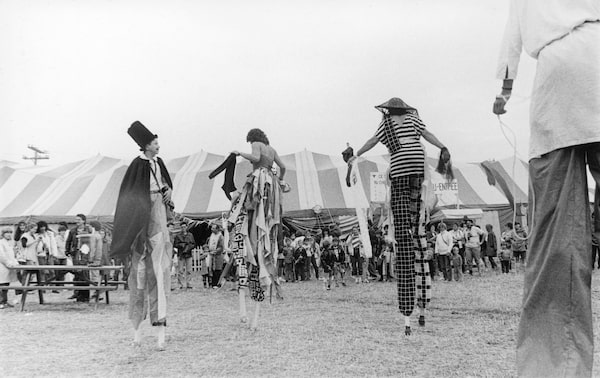
At the dawn of the 1980’s, a troupe founded by Gilles Ste-Croix took to the streets of Baie-Saint-Paul, a charming village near Quebec City. Known as Les Échassiers de Baie-Saint-Paul (The Stilt walkers of Baie-Saint-Paul), this group would form the core of what would grow into Cirque du Soleil.Cirque du Soleil
Cirque’s pre-pandemic success was grounded in its ability to juggle the competing demands of creativity and commerce. As Lamarre put it that February in Montreal, “If I were to listen to our creators, they never have enough money, and if I were to listen to our business people, we’re always spending too much.” He knew all too well what could happen when both balls were dropped. In the wake of the 2008 financial crisis, Cirque suffered a string of disappointments as the recession sapped demand for its pricey tickets and the company turned out several creative duds that left it exposed. With profits falling, Cirque laid off hundreds of executives and performers, and embarked on a plan to diversify its business, with bold talk of theme parks, cabaret shows, movies and expansion into Asia. By 2015, however, Laliberté, then 55, put Cirque up for sale, saying he wanted to spend more time with his five children but also to explore ventures in real estate, multimedia and technology. (Laliberté declined to be interviewed for this story.) Despite interest from 52 suitors, the winning bid was a consortium led by U.S. private equity firm TPG Capital, which bought a 55% stake. Shanghai-based Fosun Capital acquired 25%, and provincial pension fund manager Caisse de dépôt et placement du Québec bought 10%. The group reportedly paid US$1.5 billion for the company, with Laliberté holding on to 10%.
Aside from the predictable hand-wringing by Quebec nationalists over Cirque being owned by des capitalistes américains, the deal also caught attention for the financial acrobatics that enabled it. Like all leveraged buyout transactions, the TPG-led consortium paid for the takeover using debt, which it then put onto Cirque’s balance sheet and let grow further over the next four years. By the end of 2019, Cirque owed US$970 million in long-term debt, and Moody’s, the credit-rating agency, had warned the company’s “largely debt-funded expansion strategy could be unsustainable.” If trouble ever arose, Moody’s added prophetically, Cirque would have little room to maneuver.
Cirque’s debt load didn’t appear to concern its owners. As an LBO giant, TPG had already deployed US$50 billion in nearly 200 transactions over the previous two decades, including many media and entertainment investments. Right till the end, Cirque was generating nearly US$100 million a month in revenue and meeting its interest payments. Even today, those with knowledge of TPG’s Cirque strategy call the focus on its debt a red herring. “Our debt was basically trading at par in advance of COVID, so the markets were saying Cirque was appropriately capitalized,” says a source familiar with TPG’s thinking.
The initial focus for the new owners was on improving efficiency. “Cirque had an abundance of culture and cult-like commitment to the brand, and at the same time it had an abundant lack of controls, accountability and responsibility for [profits and losses],” says Mitch Garber, the Montreal businessman who joined the TPG-led purchase of Cirque as its chair (he was replaced last September). “It’s hard to be critical, because it worked for Guy. He’s not an org chart guy. He’s not a quarter-over-quarter growth guy, and he doesn’t necessarily hold people accountable for missing their numbers, which is something that’s necessary when running a large organization.” To that end, more rigorous corporate reporting systems were put in place, as was a more disciplined process for greenlighting new projects. As part of an efficiency drive, Cirque also quietly cut more than 50 jobs in December 2019. “We did all those things, and we were really in a great position going into 2020,” says Garber.
But the new ownership group also saw Cirque as a one-of-a-kind global live entertainment platform. “Cirque’s capability set included recruiting unique talent around the world, dealing with a tonne of visa issues, moving performers around the world, paying people in multiple currencies, and being able to take any [intellectual property] and distribute it around the world,” says the source close to TPG. “There’s a long tail of mom-and-pop shows that have made it in one-off locations. Cirque could leverage its platform to distribute more shows and more show types globally.” Pursuing that strategy between 2017 and 2019, Cirque bought Blue Man Group (the one with the blue-painted bald artists and musicians), the Works (a troupe of touring magicians) and VStar Entertainment (which produces touring shows based on kids’ programs like Paw Patrol). In total during the TPG era, Cirque invested US$300 million in acquisitions and new shows. (Not everything was a success—in addition to R.U.N.’s failure, a 40,000-square-foot football-themed interactive attraction in Times Square, launched in partnership with the National Football League in 2017, closed after only 10 months.) “We had a multiyear plan that was just about to hit its inflection point in 2020, where we were going to experience a lot of growth, on both the top line and bottom line, because of all the shows we were set to launch by the end of the year,” says the person close to TPG. “It was just horrific timing to have this kind of black swan event happen.”
By the time I met Lamarre again in Orlando in early March for the Drawn to Life preview, it was clear from the closure of Cirque’s shows in China, Hong Kong and Italy that the virus would affect the company’s plans for the year. Yet he maintained the new show at Disney Springs would open as planned for full previews two weeks later. In fact, for many of those attending the event, hope remained high that North America would be spared the worst. The optimists included me. I’d flown my family down for a side trip to Disney World, reassured by the fact the entire state of Florida had only seen a couple of cases so far.
The reality of my own naiveté was driven home 10 days after we got back to Toronto, when news broke that a 34-year-old man from California had fallen ill after visiting Disney World at the same time we were there. He tested positive for COVID-19 and was put on a ventilator. He died five days later, on March 19, a day before Drawn to Life was supposed to open its doors.
That never happened, of course. By then, Cirque was in freefall.
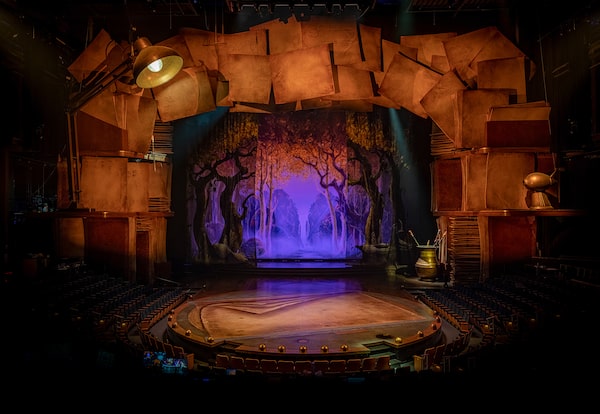
March 2020: Disney Springs resort in Orlando, the Drawn to life preview is shut down along with other Cirque shows around the globe as the virus rages forces closures of the performing arts globallyCirque du Soleil
When Emily McCarthy stepped onto the ice at the arena in Sheffield, England, as part of Cirque’s touring show Crystal in early March 2020, it wasn’t just for any regular performance. Born in nearby Leeds, McCarthy had been part of Great Britain’s acrobatic gymnastics team from a young age. While competing in Florida, she was spotted by Cirque’s talent scouts. At 16, she ran away to join the circus, a journey that took her to more than three dozen countries. As an aerialist in the finale of Crystal, it was her first chance to perform the act in front of her home crowd. “It was mega-exciting to have all my family, friends, schoolteachers and gym coaches come to see me,” says McCarthy.
It was also in Sheffield that she first started paying attention to the spreading virus. By the time the tour moved to Glasgow the following week, it was no longer a distant concern. The tour director called a full meeting to say Cirque was keeping an eye on the situation. The next day, another meeting was called, and performers were told that after the final show three days hence, everyone would be sent home. “The plan was to rekindle the show in Paris in September, and we all just thought, Wow, five months away is such a big deal,” says McCarthy.
Back at Cirque’s head office, the response to the mounting crisis had already started to scale up. The first show to close had been Cirque’s sole residency in China, X: The Land of Fantasy in Hangzhou, which shut down on Jan. 23, the same day the Chinese government imposed a dramatic lockdown of Wuhan. The move stung, given Cirque’s long-stated aspiration to grow in China, but the idea that the whole world would grind to a halt was still inconceivable.
On Feb. 21, Duncan Fisher, who’d joined Cirque two years earlier as vice-president of touring operations, got a message from a tour director with Blue Man Group, which was scheduled to travel to South Korea, where an outbreak had just occurred. Fisher spent the last week of February in Munich with the touring show Totem, which was set to visit Italy, Europe’s hardest-hit country, the next month. There, too, questions were being asked about how to proceed.
Fisher rushed back to Montreal, where he was charged with setting up Cirque’s crisis task force, which began meeting daily. Their discussions still largely focused on how Cirque could keep shows running in the face of widening government restrictions and what types of safety protocols were needed for employees and audiences. “There wasn’t any talk of us shutting down,” says Fisher. “It was, ‘How do we operate in this new reality we’re seeing?’”
As the situation worsened, the daily meetings grew to include more than 70 people. Despite their size, the gatherings were kept to around 45 minutes, with a strict time limit imposed on questions. “If we couldn’t solve your problem in 60 seconds, we’d take it to a sidebar meeting,” Fisher says. “Everybody in the company then knew exactly what was happening with every tour around the world.”
That was the first week of March. By the second, “everybody knew what was coming our way,” says Jean-François Girard-Berberi, then Cirque’s head of talent operations. “Everything was moving so fast, you had very little time to react.” (He left the company this past April.) One by one, its touring shows were shut down, and by Friday, March 13, all 13 of them—accounting for an estimated 65% of Cirque’s revenue—had closed, save for Crystal in the U.K., where the government was slower to implement lockdowns.
For Lamarre, the halt was crushing. The only consolation, if it could be called that, was that the six remaining Cirque shows in Las Vegas were still operating, though he knew the clock was ticking. On March 14, the day after the Trump administration declared a national emergency, Lamarre sat in a chair at his hairstylist’s as his phone pinged every few minutes with updates on the spreading crisis. Then came the call from MGM Resorts: All the Vegas hotels were closing, and with them the Cirque shows—O at the Bellagio, Love at the Mirage, Kà at MGM Grand, Mystère at Treasure Island, Michael Jackson One at Mandalay Bay and Zumanity at New York-New York. Lamarre excused himself and walked to his car in a daze. “I just collapsed in my car as I came to the understanding that Vegas was shutting down,” he says. “It meant we had no more shows. It meant we had no more revenue.”
As it turned out, the 1 p.m. performance of Crystal in Glasgow that Sunday would be Cirque’s last show before locking down, making McCarthy’s act one of the final performances before the company’s collapse.
Crystal follows the subconscious journey of a young woman after she falls through a frozen pond, and as McCarthy stepped onto the ice, a narrator’s voice echoed out: “It’s easy to fall, harder to get back up.” After she’s flung through the air repeatedly, McCarthy’s act culminates with her heart-stopping plunge, headfirst, toward the ice from about 20 feet in the air, where she is caught at the last moment by another performer. “I wanted it to be perfect and to take in every moment,” she says. “Once that final trick ended and I got in the finale position at the end of my act, I just started crying.”
See Cirque du Soleil performer Emily McCarthy perform a heart-stopping plunge at a performance of Crystal in Glasgow in 2020.
Cirque du Soleil
Cirque du Soleil is the United Nations of live entertainment. At its height, the company’s 4,900 employees hailed from almost 90 different countries, and it maintained a small army of translators so they could all talk to one another. On its touring shows alone, there were 1,500 performers, artists and technicians from 50 nations. Nearly all of them would soon be out of a job. And with borders rapidly closing, they all had to get home.
While many employees had heard from their local managers that shows were being put on hold indefinitely, official word came from Lamarre via a short video posted on the company’s internal communications hub at noon on March 19. Cirque would be laying off 4,679 employees, he said, retaining a bare-bones staff of 259 in Montreal. “This is a temporary situation,” he tried to assure them.
Behind the scenes, the massive logistical dance of repatriating everyone was already underway. “All the barriers at the company dropped, and everybody wanted to work together to help employees and save the company,” says Girard-Berberi. Members of the tour services team in Montreal, along with local tour managers, began frantically booking flights through Expedia for all 1,500 touring employees. With employees hailing from countries as diverse as Kazakhstan, Switzerland, Belarus, Moldova, Denmark, Taiwan, Australia, Russia, Colombia, Japan, Finland, Italy and Brazil, the flights crisscrossed the globe. All told, the bill for airfare was close to $1 million. Yet within a matter of days, the mass mobilization was complete. “From when we started shutting down, it took us 10 days to get everybody home,” says Fisher.

Ninjin Altankhuyag, a 25-year-old contortionist with the show Koozawas got stranded by the pandemic in Lyons, FranceCirque du Soleil
Well, almost everybody. Eight Mongolians who’d worked on various Cirque shows found themselves trapped when their country closed its borders, even to its own citizens. Ninjin Altankhuyag, a 25-year-old contortionist with the show Kooza, was one of them. From the age of seven, when Cirque came to Mongolia for a casting call, she’d wanted to join the company, and she got her chance in 2014. Kooza was in Lyons, France, when it was shut down. “Cirque found us an apartment to stay in until we could get back home,” she says, “We really appreciated it.” As the weeks turned to months, she mostly watched TV and cooked. “I learned a lot of new recipes,” she says. Finally, in August, they were able to snag a spot on a special charter flight to Ulaanbaatar.
Before employees left their tour sites that March, they’d helped tear down most of the tents and pack up the arena shows. Tents at three tour sites, in Melbourne, Houston and Montreal, were left up in the hope that shows might resume in the coming months, but eventually those too were dismantled. That left Fisher with the question of where to put them all, along with costumes, booths, sound and lighting equipment. Gear from Europe went to the warehouses of a trucking company in Amsterdam, while the rest was loaded into trucks and stored in Las Vegas or Montreal. In all, nearly 700 tractor-trailers were packed away.
Many of them still sit in the parking lot beside Cirque’s headquarters. “When I see them, truck after truck after truck, it just hits me in the gut,” says Leroux, the professor at Concordia, who also teaches at the National Circus School across from Cirque’s offices. “The first time I saw them, I thought, Oh my God, so this is what a multinational touring force looks like at a standstill. It’s heartbreaking to see so much creativity, so much potential, so much investment and so many dreams just sitting there in a parking lot.”
In the world of theatre, it’s tradition to leave a single lit lamp, known as a ghost light, onstage after everyone has left for the day. In Melbourne, after packing away the equipment for Kurios, that’s what employees did, where Cirque’s big top once stood at the Flemington Racecourse. The light stayed lit until this past April, when Cirque had to clear out for good.
The crisis facing Cirque wasn’t entirely unprecedented. The 1918 Spanish flu triggered government lockdowns that forced circuses across America to end their touring seasons early. In October of that year, Charles Ringling notified the 1,200 employees of the Ringling Bros. World’s Greatest Shows the circus was shutting down. The next day, it staged its final standalone performance. By the next spring, it had merged with Barnum & Bailey, and the combined company was back on the road at full force.
At Cirque, as with the rest of the world, no one knew how long COVID-19 would keep its grip on the global economy, but early on there was hope the crisis wouldn’t last. “We went from almost US$100 million a month to zero in a week, and I think we all naively thought we’d be able to recapitalize the business and by the end of the summer or beginning of fall this thing would be over,” says then chief financial officer Stéphane Lefebvre, who joined Cirque in 2016 and was recently named chief operating officer.
The financial nightmare would last much longer than that.
In theory, Cirque had three options. It could tap the government for a bailout. It could get its existing investors, TPG, Fosun and Caisse, to inject more cash to keep the company afloat. Or it could file for protection from its creditors.
Lamarre preferred the first two options, and he turned to the Caisse for support. The pension fund had extra motivation to see Cirque survive intact. Less than two months earlier, in February 2020, in what might go down as the most perfectly timed asset sale ever, Laliberté unloaded his remaining 10% stake on the Caisse for US$75 million, thereby doubling the pension fund’s exposure to the company. By early May, Cirque had secured a loan of US$50 million in “emergency funds” from its ownership group, and the Quebec government pledged up to $200 million to help Cirque get back on its feet, providing control was anchored in Quebec and the existing owners maintained control. Cirque’s immediate future seemed safe.
But there was a problem. Cirque had already failed to make roughly US$20 million in interest and principal payments to its creditors in March 2020. And just before doing so, Cirque’s ownership group had transferred intellectual property assets, including the Cirque du Soleil trademark, to a separate holding company they controlled. If Cirque filed for bankruptcy protection, lenders might no longer have a claim on the Cirque brand—arguably its most valuable asset—in many parts of the world. And bankruptcy was looking increasingly likely. Moody’s slashed Cirque’s credit rating deep into junk territory and warned the pandemic shutdown had “significantly heighten[ed] the company’s risk of default.”
When the asset shuffle eventually came to light, it put Cirque and its existing ownership group on a collision course with debtholders. “To the extent they were taking security away from the lending group and the lending group doesn’t have the ability to call on that security anymore, that reduces your pool of collateral, whether or not the company is insolvent,” says Joe Pasquariello, a partner and head of the corporate restructuring group at Goodmans, which represented a committee of secured creditors.
Enter Catalyst Capital. Controlled by secretive Toronto financier Newton Glassman, the private equity firm specializes in acquiring distressed assets, like the secured debt of struggling companies, on the cheap. It then restructures the businesses with the goal of spinning them off at a profit. Through March and April 2020, Catalyst, led by managing director Gabriel de Alba, began quietly buying up Cirque’s first-lien debt (the first in line to be paid when a borrower defaults) at around 50 cents on the dollar.
With US$4.3 billion in capital commitments, Catalyst’s strategy has put it at the centre of some of Canada’s largest restructurings, including those of broadcaster Canwest Global, steelmaker Stelco and theatre giant Imax. But it has also been stuck with holdings it failed to unload profitably, such as Advantage Rent A Car, which filed for bankruptcy protection for the third time in May 2020, and Gateway Casinos, which saw a US$1.1-billion sale collapse last year. The firm has also pushed limits in its battles with adversaries. A recent Ontario court ruling revealed Catalyst had indirectly paid up to US$11 million to Black Cube, an Israeli private investigation outfit, which carried out a sting on a former Ontario Superior Court judge who had previously ruled against Catalyst, in an attempt to discredit him. Catalyst has said it was unaware of Black Cube’s actions. (De Alba declined requests for an interview.)
In the wake of the transfer of Cirque’s trademark, Catalyst assembled an ad hoc group of other lenders and negotiated with Cirque to replace the $50-million loan from its owners with one from the creditors.
By then, though, the struggle for Cirque du Soleil’s soul had become an all-out brawl. Pierre Karl Péladeau, CEO of media giant Québecor, vowed to “rescue” Cirque with a vague pledge of “several hundred millions of dollars.” Péladeau also took a shot at Lamarre and Garber, then Cirque’s chair, on social media: “The accounting truth demonstrates beyond any doubt that the management of [Lamarre and Garber] has been more than deficient…Cirque and its talents must be saved.” (Garber fired back on Twitter: “My life would have been so much easier with much less risk if my daddy gave me my company and a few billion dollars. Unfortunately, I had to build and learn from scratch. You’ll always be the guy born at third base but convinced you hit a triple.”)
Even Laliberté wanted back in. “As Cirque faces the biggest challenge of its existence, we’re about to see a wrestling match involving a number of players,” he wrote in an open letter last May. “From my point of view, we’re in for a battle royale.”
While all this was going on, Cirque’s former employees were struggling to adjust to life off the stage. The company had allowed everyone to keep their work computers and phones so they could stay connected. Yet as billions around the world were learning, lockdowns can be gruelling, especially for people accustomed to performing daring feats of athleticism in front of cheering audiences 350 times a year.
For Crystal’s McCarthy, her very identity came into question. “From when I was 16 until 25, Cirque was all I’d known,” she says. “It’s been my one and only job, and so coming off the tour, I really was unsure about who I was.” Absent the pressures of the show, she lost her motivation to train. “I was rubbish. I was drinking wine every night, just watching Netflix and not knowing what to do with myself,” she says.
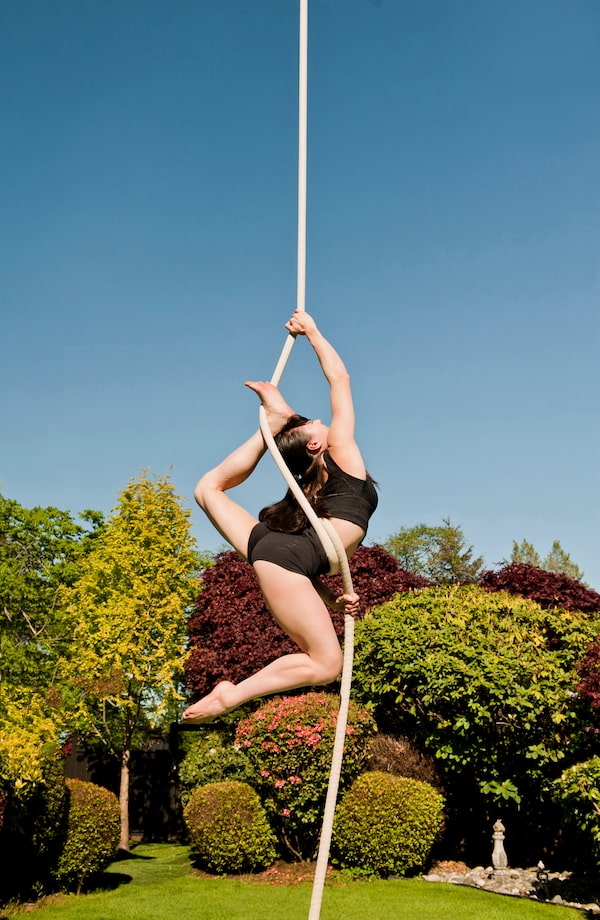
Brittany Gee-Moore installed a 24-foot rig in her parents’ backyard in Burnaby, B.C., to stay in shape during the layoffCirque du Soleil
Some of the many performers back in Montreal moved in together to form bubbles around specific acts. “If you had five people who do a Korean plank act, you’d find the largest apartment you could and all move in to train together,” says Concordia’s Leroux. Others sought out specialized gear that was sitting unused in empty gyms. Brittany Gee-Moore, an aerialist rope performer with Messi10—a show inspired by Argentinian soccer star Lionel Messi that had been on tour in Qatar—returned to her parents’ home in Burnaby, B.C., and tracked down a 24-foot-tall aerial rig that she set up in their backyard. “I’m not really sure if it was legal, but I was able to train six days a week on it, sometimes with the neighbours watching,” she says.
Aside from the physical and psychological challenges brought on by Cirque’s collapse, there was also the financial burden. Cirque often describes itself as a family, and in many cases that’s the literal truth. Workplace romances are common, so when the company shut down, many employees also had a partner who was suddenly out of work. That was the case for Caroline Lauzon, who performs in the Las Vegas show O and whose husband is a rollerblader in Love. “When we closed, I think everyone was a bit relieved they could go in their cocoon and stay safe,” she says. “But after a few weeks, it dawned on us that we’re not going back for a while.”
Lauzon was fortunate to have obtained her real estate licence a few years earlier—”I’m going to be 40 in two years, so I had to plan ahead because the body can’t do Cirque forever”—so she began working in Las Vegas’s surging real estate market. She knew others who weren’t so lucky. The previous winter, Cirque had hired 40 more artists for O in order to perform the show seven days a week, but they hadn’t worked long enough to qualify for unemployment benefits. “Some of them spent all their money moving here and had no money coming in,” Lauzon says. “They were standing in lines for free food.” Lauzon set up a GoFundMe campaign that raised enough to give US$1,000 each to 21 performers.
While Cirque’s full-time employees had all been paid in full for the work they’d done before the layoff, that wasn’t the case for the many contractors and freelancers. Gabriel Dubé-Dupuis grew up around Cirque—his father played the Baby in Mystère when the show debuted in Vegas in 1993—and he joined the company 25 years ago. He was a creative director for shows being developed for cruise ships when Cirque terminated his contract. Dubé-Dupuis was still owed $70,000 and was told that as a supplier, he was at the bottom of the list of creditors. “I was shocked,” he says. “If we provided basically the soul of the company over the last 35 years, how can you consider us the same way you would consider Hydro-Québec providing electricity to the building?” In May and June 2020, he organized protests in Montreal with other Cirque contractors who were owed a combined $1 million. But as the summer wore on, he didn’t know when or if he would be paid.
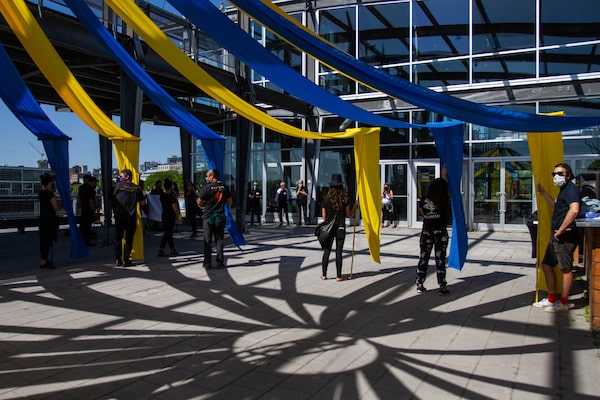
Members of the RAAC (Regroupement des Artisans des Arts du Cirque) raised this symbolic big top on June 16th, 2020, the day of the Cirque du Soleil's anniversary. Over 130 members of the RAAC were owed more than $1.5 million in unpaid wages.Fannie-Laurence Dube-Dupuis/The Globe and Mail
As for McCarthy, she recalls the day she woke up and realized only one person could determine how long she’d feel unmotivated. She started training again that morning. Her brother had started his own company selling calisthenics and bodyweight training equipment, so she bought a stake in the business. She also set up her own YouTube channel, which amassed 70,000 subscribers, and began offering flexibility classes on Zoom.
“I feel very fortunate to have had such a good experience over this,” McCarthy says, “even though it took me a little while to get there.”
Cirque du Soleil itself saw a bit of good news last summer. Immediately after its live shows shut down, the company launched a digital portal, CirqueConnect, and began airing weekly specials featuring acts from its shows. The videos quickly racked up more than 65 million views. Meanwhile, Cirque’s corporate partners were stepping up—Sun Life, a longtime sponsor and Cirque’s group insurance provider, kept its rates at the level of a company with nearly 5,000 employees, even though the insured group had shrunk dramatically. What’s more, by early June China had brought the virus under control, paving the way for Cirque’s show in Hangzhou to relaunch. Performances of another show, Joyà, at the Riviera Maya resort in Mexico, resumed shortly after.
Reality soon came crashing back. With its emergency funding running out, Cirque buckled under the weight of its debt and the ongoing shutdown, and filed for protection from its creditors late in June 2020. At the same time, it announced a so-called stalking-horse bid (which sets a floor for other bids to follow) from existing shareholders, through a new company called Trapeze Holdings, that would see them reduce the company’s debt and inject US$300 million to restart its shows. The proposal would leave Cirque’s creditors holding just 45% of the equity.
In an internal video to employees, Lamarre called the filing a “necessary step for Cirque’s survival and a springboard for the organization’s revival,” but he also let them know Cirque “can no longer afford to keep our employees on temporary layoff.” The layoffs were now permanent, save for about 600 workers in Las Vegas and Orlando who would be kept on to help shows in those cities eventually relaunch.
The bankruptcy filing blindsided the creditor group, which had signalled interest about launching its own stalking horse bid, says Pasquariello, the lawyer representing Cirque creditors. The group of lenders quickly signalled it wouldn’t support the transaction. “The lender group wasn’t interested in dilly-dallying when a bid wasn’t going to be serious and competitive with the lending group’s own offer,” says Pasquariello. Days later, the creditors put forward their own offer, through their own circusy-named holding company, Spectacle BidCo., to buy, among other assets, “the storyline, plot, themes, characters, concept developments, ideas, costumes, sets, props, choreographies, performances, makeup design, lighting concepts, sound designs, musical compositions and staging of any live entertainment program” of Cirque for US$1.2 billion, including US$375 million in new money. The deal would cut Cirque’s debt by more than 30%. The creditor group also committed to keeping Cirque’s headquarters in Quebec for at least five years.
Other bidders had until Aug. 18 to come up with better offers, but they all had to meet one somewhat unusual demand. Embedded in the first Trapeze bid was a non-negotiable Cirque requirement that whoever ended up owning the company would establish a US$15-million fund to help terminated employees, and another fund for freelancers and contractors. “It was odd,” says then CFO Lefebvre, “but when you know what the DNA of this company is, it’s not a surprise that we would think about these things.”
In every way, the pandemic made the already complex proceedings even more strained. Lefebvre and Lamarre had to do half a dozen five-hour presentations to potential bidders virtually. Hundreds of teleconference calls were made between creditors, lawyers, existing shareholders and financial advisers, all while juggling stay-at-home orders, family demands and pandemic stress. “I think every financial and legal professional who has played in this field over a long time would say this was one of the most challenging restructuring files they’d ever seen,” says Pasquariello.
While a wide array of potential bidders reportedly examined Cirque’s books, including Quebecor, Rogers Communications, Goldman Sachs and Feld Entertainment (which once owned Ringling Bros. and Barnum & Bailey Circus and now operates Disney on Ice), no bid could top that of the creditors. As lenders, only they could include the face value of the company’s US$1 billion in debt as part of their bid, an insurmountable hurdle for other contenders.
With that, Cirque became a holding of its lenders, led by Catalyst and including Sound Point Capital and CBAM Partners of New York. It struck many as an odd fit. A company that embodies hope and joy was now controlled by one of Bay Street’s most ruthless dealmakers in Glassman, who once told a reporter, “You have to be unaffected by conflict to be decent at distressed [debt investing] because it’s a highly adversarial process…You are dealing with desperate people, and desperate people try desperate things.”
The deal received court approval and closed in November 2020. Most of Cirque’s existing management team stayed in place, and Jim Murren, the former CEO of MGM Resorts International—Cirque’s biggest partner in Vegas—was named co-chair with de Alba.
As for TPG, Fosun and Caisse, their equity holdings were wiped out. For the Caisse, that meant not just the US$71 million it invested in 2015, but also the US$75 million it paid Laliberté only four months before the bankruptcy filing. When Caisse CEO Charles Emond was later grilled by the Quebec National Assembly’s public finance committee, he defended both the February purchase, which he claimed would have given the fund more sway to address Cirque’s swelling debt, and the decision to write off its stake. “The Cirque went from $100 million per month to zero, with employees to pay and suppliers to pay, in 48 hours,” he said. “It was probably the first business to close. It will most likely be the last to reopen.”
One year after Cirque du Soleil’s nightmare began, in March, Lefebvre and Lamarre held a video call with employees. The message was simple, says Lefebvre: “We might not be out of the worldwide health crisis at this time, but the company is definitely out of its financial crisis created by the public health crisis.”
Normalcy has begun to return, slowly. In March, Dubé-Dupuis, who was among the contractors still waiting to be paid for work completed before the pandemic, got a call from his bank asking why $70,000 had just been deposited into his account. He’d reached out to Catalyst after it won control of Cirque and told the new owners of the contractors’ situation, and de Alba assured him Cirque was working on it. In all, US$3.6 million was paid out to Cirque’s former contractors and freelancers that month. “This is a step in the right direction,” Dubé-Dupuis said the day after getting paid. “Good things can happen.”
Payments from the special US$15-million employee fund are also close to being issued, Cirque officials say. The fund got bogged down last fall in a dispute between Canada Revenue Agency and Cirque’s new owners over the tax treatment of the payments, which would amount to US$3,000 per employee. At one point, an exasperated Quebec Superior Court judge, Louis Gouin, who oversaw the bankruptcy filing, urged the two sides to work out their differences on compassionate grounds. “This is my human side talking,” he told the lawyers. “These are really exceptional times. Those acrobats can’t find a job tomorrow. I very much, very much would prefer that you find a way to do this.”
The clearest signal that Cirque’s revival is underway came this April, when it officially announced its long-awaited return plan. After Nevada’s governor set a goal of reopening the state at full capacity by June 1, Cirque picked two shows to lead its relaunch—Mystère at Treasure Island in late June and O at the Bellagio on July 1. It was a symbolic choice: The two shows were Cirque’s first resident performances in Vegas in the 1990s and helped rewrite the idea of the city as an entertainment destination while also catapulting Cirque to new heights as an international brand.
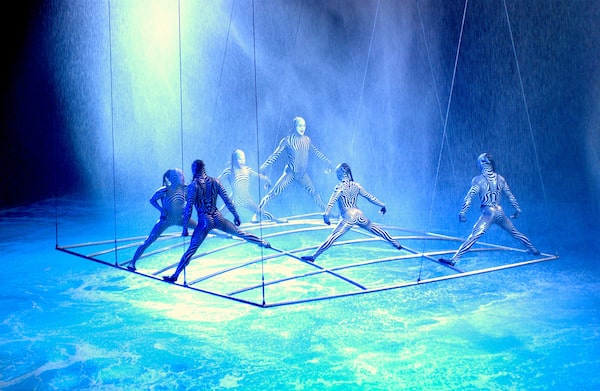
O was one of Cirque’s first resident shows in Las Vegas, and it’ll be among the first to restart post-pandemicCirque du Soleil
Cirque’s remaining Vegas shows, Love, Michael Jackson One and Kà, will follow this fall. (Missing from the list: Zumanity, the Cirque’s R-rated venture into erotic cabaret. After 17 years, it was closed for good last November.) In Florida, the company is hoping to launch Drawn to Life sometime in the fall. Two of Cirque’s touring shows also got start dates—Kooza will begin performances in the Dominican Republic in November, followed by Luzia at London’s Royal Albert Hall next January. “The intermission is over,” says Lamarre.
Cirque’s revival is a moment Diane Quinn has been preparing for. When the COVID-19 crisis began, Cirque’s chief creative officer threw herself into the world of pandemic research. As her understanding grew, her questions for the experts became more specific. What effect does virus shedding have on the distance particles travel when Cirque’s singers are performing live? How far apart should clowns be when speaking to each other or to audiences? What types of HVAC facilities are in place in different venues? “I don’t pretend to be an expert, but I feel like I’ve had quite an education in COVID,” says Quinn.
Last December, she got an opportunity to put some of what she’d learned into practice. In Kissimmee, Fla., a small circus show Cirque had acquired was gearing up to perform over the holidays. Quinn recorded the square footage of all the rooms, traced the paths everyone would walk backstage to ensure they didn’t get too close and established an isolation booth in case someone showed symptoms. It was also a chance to test the company Cirque has hired to conduct daily testing—to gain access to the theatres, employees will have to display a QR code on their smartphones proving they’ve tested negative. “I was filled with anxiety, wondering, How can I keep all of these artists and staff safe?” she says. The work paid off. “There were no issues, no cases, no sickness, and we provided a socially distanced show for the audience.”
That show had nine performers. Replicating that for a complex 90-minute spectacle like O with a cast of 85 is next. “Regardless of whether we have one show up and running or 20 shows, these are the policies and procedures everyone is going to abide by,” Quinn says.
Even so, relaunching just one Cirque show will be a huge undertaking. Each will require roughly two months of intense training and rehearsals, and cost between US$2 million and US$4 million to restart. The decision to proceed in Vegas is also a wager that another wave driven by COVID variants doesn’t force another shutdown. So far the news is good. At the end of April, Nevada’s seven-day average for new cases was 372, roughly in line with where it had been two months earlier, while 43% of adults in the county had received at least one vaccine dose.
A quick scan of ticket-booking sites for O and Mystère revealed both had sold roughly half the seats to their first few performances in a matter of days. For the following weeks, however, most seats were still up for grabs. Lamarre is betting that will change as the vaccine rollout accelerates and stir-crazy Cirque fans from other parts of the country desperately flee their lockdown digs. “If you’re an American and you are vaccinated, then you’re going to want to travel,” he says. “But guess what? There’s almost nowhere in the world for them to go, so they’ll probably decide to go to Vegas or Orlando.”
Early in April, a TV crew from Mark Burnett’s L.A. production company arrived in Las Vegas. Burnett, the creative mind behind Survivor and The Apprentice, had already been working with Cirque pre-pandemic to develop a reality show centred on the casting process. Now the cameras are following the on- and off-stage lives of Cirque performers as they prepare to bring its famous water show, O, back to life. “We really want to shine the spotlight on the artists, technicians and individuals throughout the company moving forward, not just for this project but for our global content slate,” says Sébastien Ouimet, director of global content and strategic partnerships at Cirque. “We’ll continue filming until O is back performing, and we can feel the excitement of mission accomplished.”
No one at Cirque is under any illusion that mounting a handful of shows means the company has reclaimed its former glory. Putting the massive machinery of Cirque’s touring division back together is expected to stretch well into 2022. Cirque will eventually have to find a way to move its people and gear back into place in a world where vaccine passports and COVID flare-ups may be the norm. Tour schedules are also typically mapped out up to 18 months in advance to line up promoters, secure locations and ensure shows can move from city to city with minimal downtime. “The reboot of Cirque is not like just putting Lady Gaga back on tour. This is going to take months to years of investment,” says the source familiar with TPG’s original Cirque plans, now watching from the sidelines. Moody’s, a more impartial observer, likewise noted in December that Cirque’s relaunch will burn through much of its cash by the end of 2022, “leav[ing] Cirque du Soleil with limited flexibility to absorb any material underperformance against their business plan during the extended ramp-up phase.” However, Moody’s also believes Cirque “will be able to rebuild scale with limited investment by leveraging a portfolio of shows with longstanding popularity.”
Fisher, the man in charge of remounting Cirque’s touring division, is philosophical about the challenge. “How do you eat an elephant? You do it one bite at a time,” Fisher says. When the world has sufficiently reopened, touring shows will be launched gradually, likely two at once, he says. Meanwhile, Lefebvre says the US$375-million capital infusion Cirque received from its new owners means he doesn’t anticipate needing to raise capital to finance the revival.
One question facing Cirque is how many of its former employees will come back. “I don’t think people understand how difficult it is to let go of 4,000 acrobats and then just will them back one day,” says former chair Mitch Garber.
In one troubling sign, En Piste, the National Circus Arts Alliance of Canada, surveyed nearly 400 circus artists late last year and found 94% were considering a career change. Cirque, however, has contacted many of its former employees and found more than 90% are eager to return.
Perhaps a bigger question—after the layoffs, the bankruptcy and the ownership change—is whether Cirque can recapture the edge that once defined it. Quinn, Cirque’s chief creative officer, predicts the crisis will give birth to a “creative renaissance…We’ve all gone through a lot of hardship over the last year, but the ideas people are already having are hopeful and joyous and full of positivity.”
Ultimately, though, Cirque’s creative future depends entirely on the new owners, says Yasmine Khalil, Cirque’s former chief executive producer, who left the company last fall. Is their goal to stabilize their investment or take on new risks? “A brand that is loved and known for innovation, creativity and joy at a time when that’s what we need the most is a tremendous opportunity for Cirque to leap into new opportunities,” she says. “But ultimately, if you don’t continuously reinvent yourself, I think you run the risk of ending up like Polaroid, a company that was very strong in one field but failed to pivot.”
So far Cirque’s new owners have said little about their long-term vision. In the only public comments Catalyst’s de Alba has made since the takeover, he said Cirque’s future lies in the digital realm. “You’ve seen that Disney is bringing some theatrical shows to Disney+, like Hamilton, with great success,” he told The Globe and Mail last August. “I foresee that Cirque shows can also be part of these types of streaming platforms.” It’s a strategy Cirque had been inching toward prior to the pandemic, and its success with its CirqueConnect digital hub and ongoing projects to bring a Cirque-related animated children’s show to life prove the strategy has potential.
As for Lamarre, he’s optimistic (as usual) about Cirque’s new owners. “People fall in love with Cirque du Soleil, and that’s what I’m observing again right now,” he says. “We’ve spent a lot of time together, which is as important to me as it is to them, because I want them to understand our business inside and out.”
Above all, Lamarre is aching to experience a live Cirque performance once again. “I cannot wait to do what I love in life, which is go to all these shows, go backstage, and chat with our artists and be fed by their passion,” he says. “For the last year I’ve tried to visualize Cirque’s revival. Now I don’t have to force myself to visualize it, because it’s happening.”

Dozens of tractor-trailers loaded with gear are parked outside, waiting for shows to reopen post-pandemic, March 2021Benoît Paillé/The Globe and Mail
Your time is valuable. Have the Top Business Headlines newsletter conveniently delivered to your inbox in the morning or evening. Sign up today.